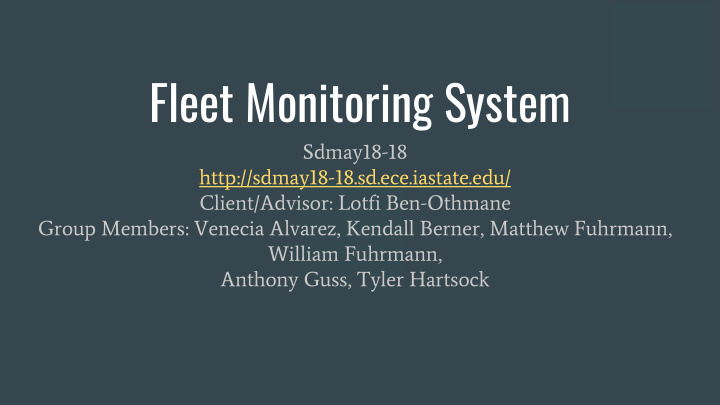



Fleet Monitoring System Sdmay18-18 http://sdmay18-18.sd.ece.iastate.edu/ Client/Advisor: Lotfi Ben-Othmane Group Members: Venecia Alvarez, Kendall Berner, Matthew Fuhrmann, William Fuhrmann, Anthony Guss, Tyler Hartsock
Problem Statement Problem: - Companies have many vehicles - Vehicle fleets are inefficient and costly Solution: - Allow a fleet manager to see real time data of vehicles - Allow a fleet manager to see periodic reports about each vehicle and each driver
Functional Requirements The product shall: - Gather data from a vehicle’s ODB-II port - Transmit data from the vehicle to the server - Process raw data from the vehicle on the server - Record vehicle data into a database - Display a map with a location of all vehicles in the fleet - Display historical data for a certain vehicle
Non-Functional Requirements The product shall: - Be used by vehicles at any time and location - Utilize Google Cloud services - Only allow managers to view fleet data on the dashboard - Have the server side code made in Node.js - Use AngularJS on the client side
Market Survey Other Fleet Management Applications: - Mobile App vs OBD II - Live tracking, statistics, vehicle data - Live map of fleet Our Application vs Rest of Market: - More useful interpretations of internal data - Automate tedious tasks
Basic Design 3 Components - Microcontroller to retrieve vehicle data - Server with database to receive, store, and relay - Website to display data to manager
Risk Management Limited knowledge of embedded systems → Lots of time spent researching, ● working with other students with embedded systems experience ● Unable to use original hardware → Use a Raspberry Pi Difficulty testing with just one device → Making fake test data ● Race conditions with the map → Research common solutions and redesign ●
Project Budget Original hardware: Android Board, development kit ● ~$500 ○ New hardware: Raspberry Pi, GPS, and connector ● $50 + $30 + $10 = $90 ○ ● Google Cloud services $40/month * 5 months = $200 ○
Project Schedule
Detailed Design - Front End User Interfaces: Emphasis on visualizing data Technologies Used: AngularJS, Chart.js, Google Maps API, Bootstrap Test Plan: UwAmp/XAmpp for local testing
Detailed Design - Server Technologies Used: NodeJS, MongoDB, Mongoose Test Plan: Automated API Testing Using Postman, Unit Testing for Data Analysis Hosted on Google Cloud Compute Engine Swagger Documentation Transitioning into a Swagger based API
Detailed Design - Microcontroller Three Modules: gps_interface, can_interface, server_send Technologies Used: Python, PiCAN2, Adafruit Ultimate GPS, gpsd, PyCan, requests Test Plan: unittest.py, verify with simulator, compare with car actuals
Current Project Status Prototypes for Python application, server, and front-end completed with interoperability.
Group Contributions Venecia: Client side, emphasis on Google Maps API and AngularJS Kendall: Client side, emphasis on Chart.js Matthew: Android application for OBD-II, GPS, sending data. Attempted to fix Android hardware. William: Android, Python, and ODB-II Anthony: Tyler:
Plan for Next Semester Expand functionality for server and front-end. Move to real vehicle use for Raspberry Pi. Increase PID support for Python application.
Recommend
More recommend